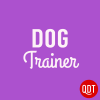Teach Your Puppy to Like Human Handling
Teach your puppy to accept and enjoy handling as a normal part of life.

Starting with a young puppy gives you a leg up. In my article on socialization, I described the “sensitive period” of life, which continues up to the age of 12 to 16 weeks. During this period, puppies learn which experiences are normal and safe–and those experiences should include human handling.
Teach Your Dog to Like Human Handling and Touch
As you cuddle your puppy, gently manipulate body parts. Stretch out his legs; press his paw pads to extend his toes. Take hold of his upper and lower jaws, open his mouth gently, and pop in a tiny piece of chicken. Practice that a few times, then hold his mouth open a little longer and play dentist–inspect those bright white teeth. Clip a toenail every day, and every time you clip a toenail, give your puppy a treat.
Hold his head steady and look into his ears. Lift up his tail and touch his anus with a gloved finger or the tip of a cotton swab–he’ll be getting his temperature taken at the vet’s for the rest of his life.
Do Handling Exercises with Your Puppy
With a tissue or a moistened towel, clean sleepy gunk from the corners of your puppy’s eyes. Even if he has a short coat, give him a few strokes with a soft brush every day. Wipe his legs and feet with a towel. You’ve seen video of monkeys picking through each other’s coats looking for fleas? Pick through your puppy’s coat just like that. Unless you’re one of those rare people who never ever forgets the preventive, you will probably find yourself plucking ticks someday.
Teach Your Puppy to Accept Restraint
Dogs sometimes have to be restrained–at the vet’s, for instance, when blood is being drawn. Many trainers advise that you teach your puppy to accept restraint by cradling her on her back and, if she struggles, not letting her go till she gives up. That approach does work with many or most pups, but a significant minority struggle frantically–I would even call them panicked. Some frantic puppies just keep trying to escape; some will experiment with a growl or a nip. And, of course, you can’t know whether your puppy falls into the “Eh, I’m being held” group or the “Lemme go lemmego lemme go!” group till you’ve made the experiment. Guess wrong and it gets mighty hard to convince Baby Dogalini that restraint is really okay after all. Not to mention that she trusts you a little less than she did before.
Teach Restraint Gradually
So, instead of holding your puppy while she struggles and letting her go when she gives up, do this: Pick a time when she’s relaxed and sleepy to begin with, then hug her and hold her still for a nanosecond. Release her before she has time to do more than notice that she’s being held. Over a couple of weeks, gradually prolong the time for which you hold her still, but take care to stay within her comfort zone.
If you hit a point where she begins to struggle,
let her go immediately. If you hang on, and her struggles escalate to the point where you must let her go, she will have learned to struggle frantically. Bad lesson. Next time you do the exercise, go back to a much shorter period of restraint and work your way back up, slowly, over time. If you keep running into trouble, get competent professional help. You can probably muscle your way around a puppy, but pound for pound even a small dog is stronger and faster than a person, and of course she has pointier teeth. The road of confrontation leads nowhere good.
How to Cut Your Dog’s Nails
As for adult dogs who are skittish about touch, the best response depends on the extent and intensity of the skittishness. At one end of the spectrum is the dog who, say, holds still while you clip one nail but pulls away when you go for a second. With such mild problems, you may make substantial headway on your own. Start with a tired, relaxed, and somewhat hungry dog. Clip one nail and immediately deliver a delicious treat, then quit. Repeat every day for a week, then give a second nail a go after you’ve delivered that treat for the first nail. Each week, add another nail. Keep those between-nail treats coming! Another trick is to smear the front of the refrigerator with peanut butter or cream cheese and clip nails while your dog is distracted by all the lickable deliciousness.
What Should You Use as a Doggy Nail File?
You can also make a doggy nail file out of a board with glued-on sandpaper or abrasive stair treads, then teach your dog to wear down his own nails. The doggy nail file needs an article of its own, but the Resources section includes links to instructions for making one and teaching your dog to use it.
Teach Your Dog to Accept Being Groomed
For mild grooming problems, combine a tired, relaxed, hungry dog with just a brushstroke or two, followed by a deluxe meaty or cheesy treat. Over the course of days or weeks, depending on how quickly your dog grows comfortable, add more brushstrokes, and keep the treats coming.
When Can You Stop Giving Treats?
People often want to know when they can stop giving treats. You can thin out the treat frequency as your dog becomes more and more comfortable with handling. But really, what is the problem with giving Dogalini a tiny piece of cheese or chicken every 15 or 30 seconds while you groom her? Especially if you start with a dog who’s twitchy about some aspect of handling, there’s no harm in constantly refreshing that new, positive association.
What to Do If Your Dog Aggresses
If your dog spooks easily, or resists several kinds of handling, or responds to handling by stiffening, curling his lip, growling, or any other display of aggression, you’ll need a careful behavior modification program. Check out my article on how to find a competent behavior counselor.
By the way, many people whose rescue dogs have difficulty with handling take this to mean their dog was abused. That’s certainly possible, but, more likely, your dog just didn’t get a lot of human handling in early life and so never learned to feel comfortable with it. Whatever the cause, you can probably make a big dent in the problem with patience and the right professional help.
Visit me on Facebook, email dogtrainer@quickanddirtytips.com, or call 206-600-5661. I answer questions when I can, and may use them in future articles.
Resources
Shirley Chong’s instructions for the doggy nail file are here. A somewhat more detailed explanation by a South African trainer, Claire Grobbelaar, is here. You’ll need basic clicker training skills; I’ve posted my primer as a Note on my Facebook page. Much more information is available in the articles at www.clickertraining.com, and I especially recommend Melissa Alexander’s wonderful book Click for Joy.
Here are some YouTube videos of dogs using nail files. Something I like about all of them: there are technical mistakes in the training, and you can see that the process works anyway! You don’t have to be perfect.
Margaret with Max
Bella Gets Pet-icure
Dog Nail Filing Board


